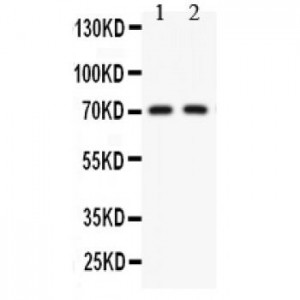More info
Overview
Long Name | Antibody Type | Antibody Isotype | Host | Species Reactivity | Validated Applications | Purification |
| potassium voltage-gated channel, Shal-related subfamily, member 2 | Polyclonal | IgG | Rabbit | Human, Mouse, Rat | WB | Immunogen affinity purified. |
Immunogen | ||||||
| E.coli-derived human Kv4.2 recombinant protein (Position: M1-N177). Human Kv4.2 shares 99% amino acid (aa) sequence identity with both mouse and rat Kv4.2. | ||||||
Properties
Form | Lyophilized |
Size | 100 µg/vial |
Contents | Antibody is lyophilized with 5 mg BSA, 0.9 mg NaCl, 0.2 mg Na2HPO4, 0.05 mg NaN3. *carrier free antibody available upon request. |
Concentration | Reconstitute with 0.2 mL sterile dH2O (500 µg/ml final concentration). |
Storage | At -20 °C for 12 months, as supplied. Store reconstituted antibody at 2-8 °C for one month. For long-term storage, aliquot and store at -20 °C. Avoid repeated freezing and thawing. |
Additional Information Regarding the Antigen
Gene | KCND2 |
Protein | Potassium voltage-gated channel subfamily D member 2 |
Uniprot ID | Q9UK17 |
Function | Voltage-gated potassium channel that mediates transmembrane potassium transport in excitable membranes, primarily in the brain. Mediates the major part of the dendritic A-type current I(SA) in brain neurons (By similarity). This current is activated at membrane potentials that are below the threshold for action potentials. It regulates neuronal excitability, prolongs the latency before the first spike in a series of action potentials, regulates the frequency of repetitive action potential firing, shortens the duration of action potentials and regulates the back-propagation of action potentials from the neuronal cell body to the dendrites. Contributes to the regulation of the circadian rhytm of action potential firing in suprachiasmatic nucleus neurons, which regulates the circadian rhythm of locomotor activity (By similarity). Functions downstream of the metabotropic glutamate receptor GRM5 and plays a role in neuronal excitability and in nociception mediated by activation of GRM5 (By similarity). Mediates the transient outward current I(to) in rodent heart left ventricle apex cells, but not in human heart, where this current is mediated by another family member. Forms tetrameric potassium-selective channels through which potassium ions pass in accordance with their electrochemical gradient (PubMed:10551270, PubMed:15454437, PubMed:14695263, PubMed:14623880, PubMed:14980201, PubMed:16934482, PubMed:24811166, PubMed:24501278). The channel alternates between opened and closed conformations in response to the voltage difference across the membrane (PubMed:11507158). Can form functional homotetrameric channels and heterotetrameric channels that contain variable proportions of KCND2 and KCND3; channel properties depend on the type of pore-forming alpha subunits that are part of the channel. In vivo, membranes probably contain a mixture of heteromeric potassium channel complexes. Interaction with specific isoforms of the regulatory subunits KCNIP1, KCNIP2, KCNIP3 or KCNIP4 strongly increases expression at the cell surface and thereby increases channel activity; it modulates the kinetics of channel activation and inactivation, shifts the threshold for channel activation to more negative voltage values, shifts the threshold for inactivation to less negative voltages and accelerates recovery after inactivation (PubMed:15454437, PubMed:14623880, PubMed:14980201, PubMed:19171772, PubMed:24501278, PubMed:24811166). Likewise, interaction with DPP6 or DPP10 promotes expression at the cell membrane and regulates both channel characteristics and activity (By similarity). |
Tissue Specificity | Detected in ovary, in corpus luteum and in granulosa and theca cells in the follicle (at protein level) (PubMed:15991246). Highly expressed throughout the brain (PubMed:10551270, PubMed:10729221). Detected in amygdala, caudate nucleus, cerebellum, hippocampus, substantia nigra and thalamus (PubMed:10551270, PubMed:10729221). Expression is not detectable or very low in heart, kidney, liver, lung, pancreas and skeletal muscle (PubMed:10551270, PubMed:10729221). Not detectable in human heart atrium (PubMed:12395204). |
Sub-cellular localization | Cell membrane. |
Sequence Similarities | Belongs to the potassium channel family. D (Shal) (TC 1.A.1.2) subfamily. Kv4.2/KCND2 sub-subfamily. |
Aliases | KCD2 antibody|KCND 2 antibody|KCND2 antibody|KCND2_HUMAN antibody|KIAA1044 antibody|MGC119702 antibody|MGC119703 antibody|Potassium voltage gated channel Shal related subfamily member 2 antibody|Potassium voltage-gated channel subfamily D member 2 antibody|RK 5 antibody|RK5 antibody|Voltage gated potassium channel Kv4.2 antibody|Voltage gated potassium channel subunit Kv4.2 antibody|Voltage sensitive potassium channel antibody|Voltage-gated potassium channel subunit Kv4.2 antibody |
Application Details
| Application | Concentration* | Species | Validated Using** |
| Western blot | 0.1-0.5μg/ml | Mouse, Rat Human | AssaySolutio's ECL kit |
AssaySolution recommends Rabbit Chemiluminescent WB Detection Kit (AKIT001B) for Western blot. *Blocking peptide can be purchased at $65. Contact us for more information

Anti- Kv4.2 antibody, ASA-B1144, Western blotting
All lanes: Anti Kv4.2 (ASA-B1144) at 0.5ug/ml
Lane 1: Rat Brain Tissue Lysate at 50ug
Lane 2: Mouse Brain Tissue Lysate at 50ug
Predicted bind size: 71KD
Observed bind size: 71KD
All lanes: Anti Kv4.2 (ASA-B1144) at 0.5ug/ml
Lane 1: Rat Brain Tissue Lysate at 50ug
Lane 2: Mouse Brain Tissue Lysate at 50ug
Predicted bind size: 71KD
Observed bind size: 71KD



